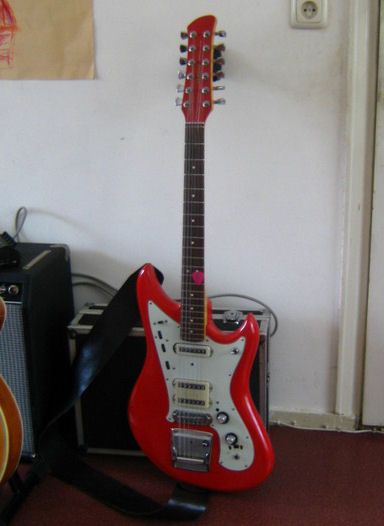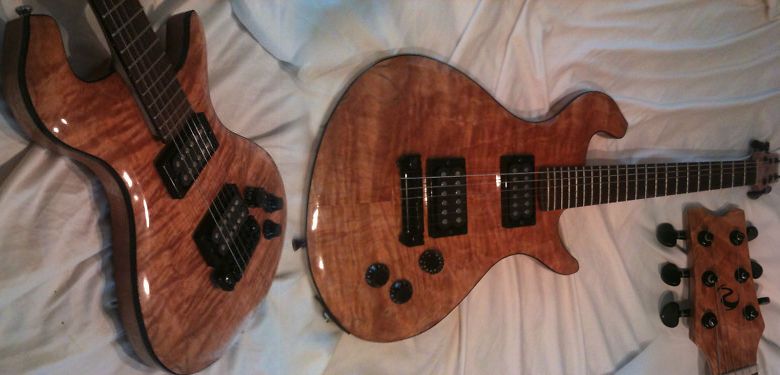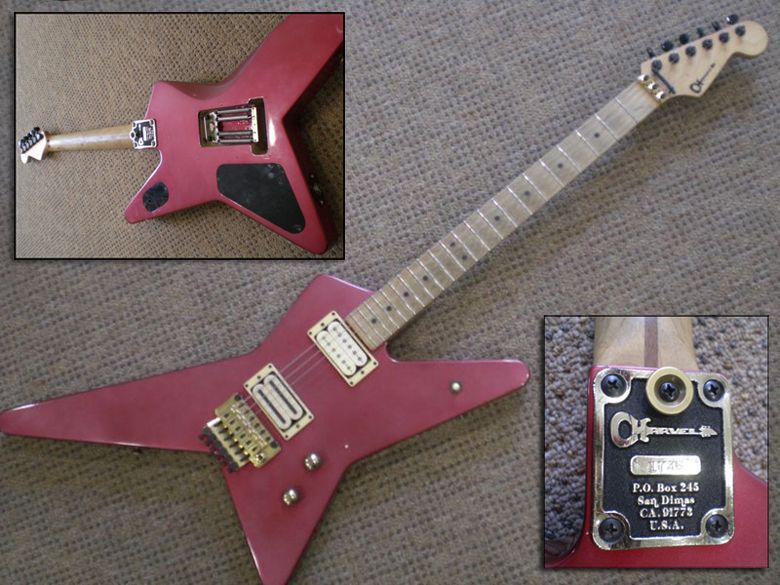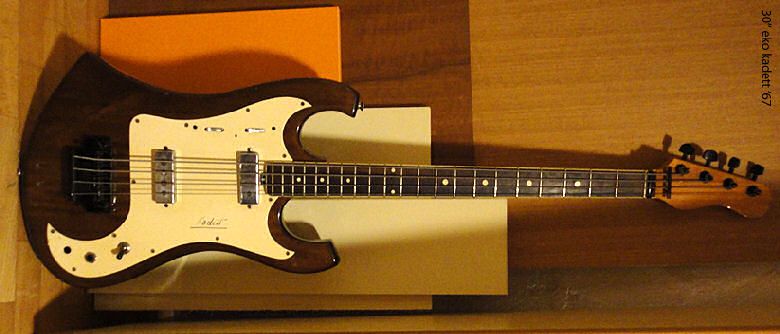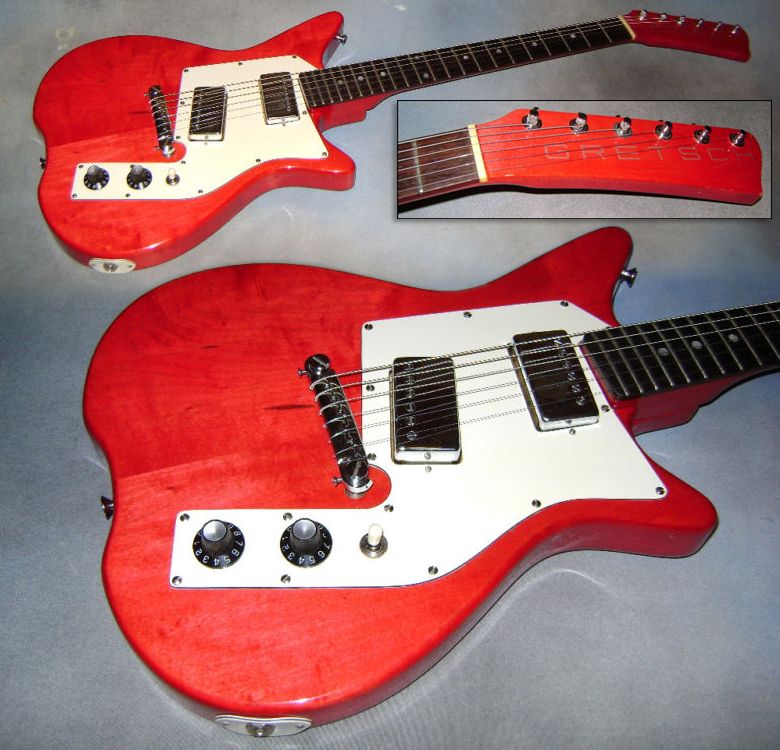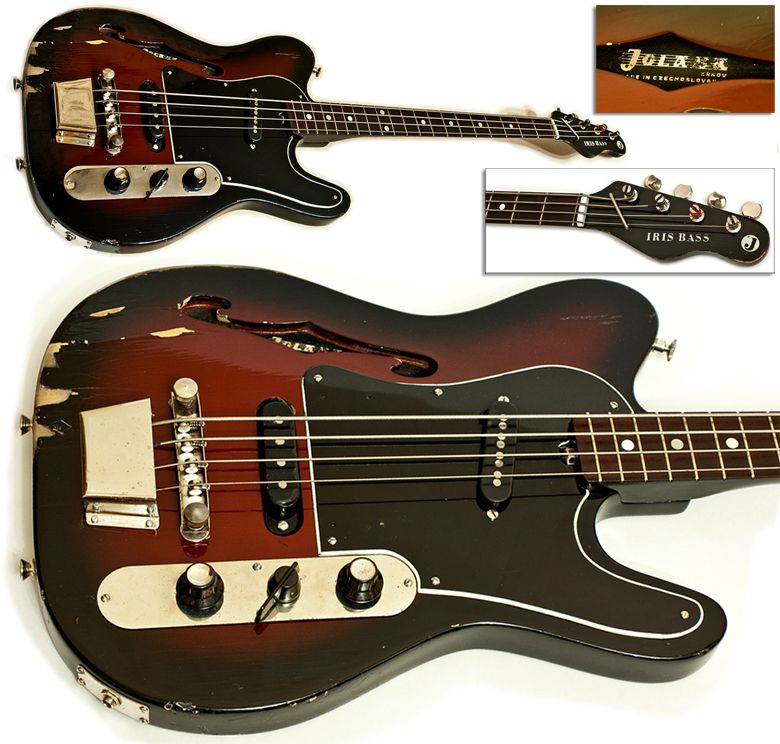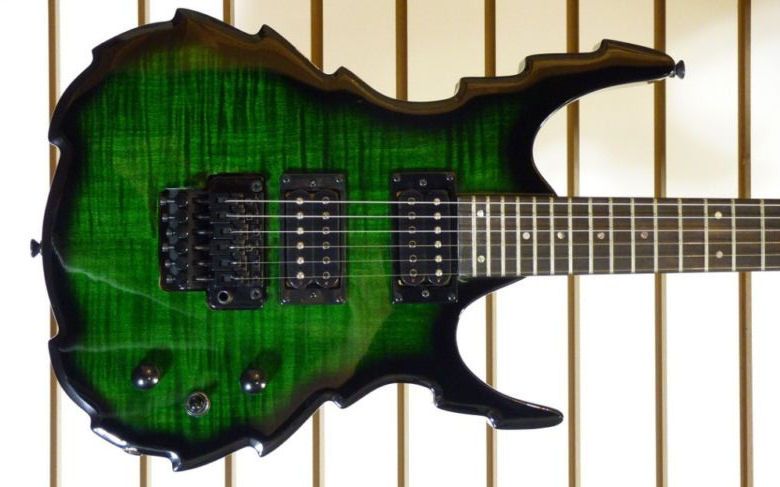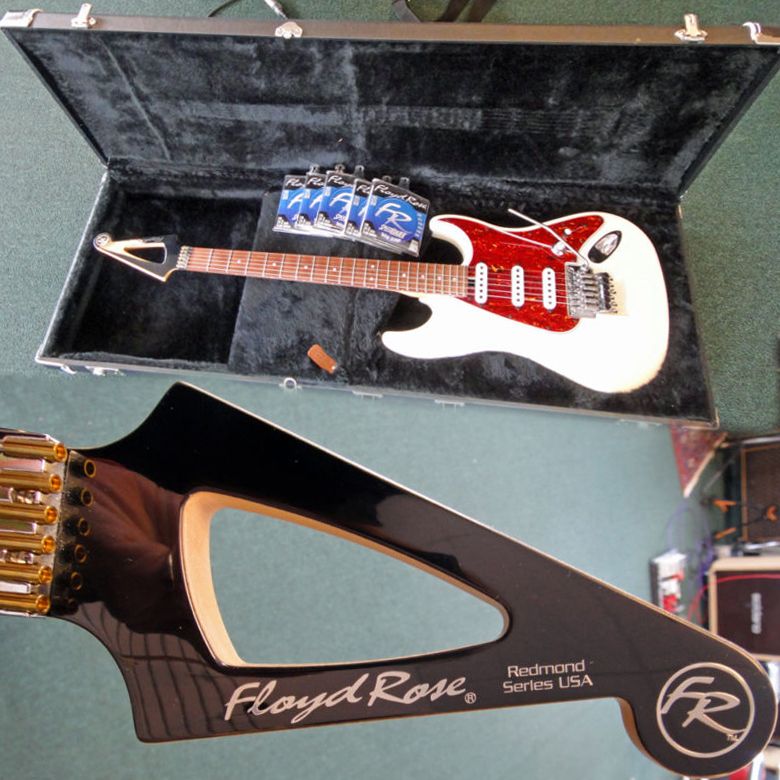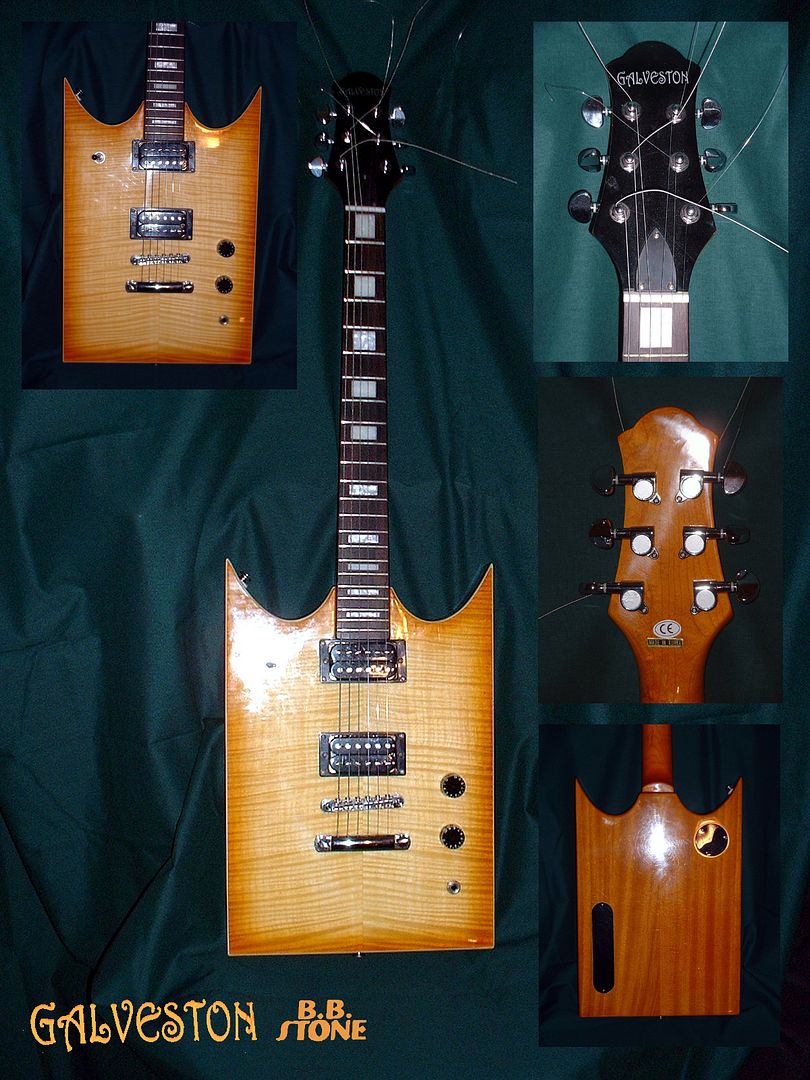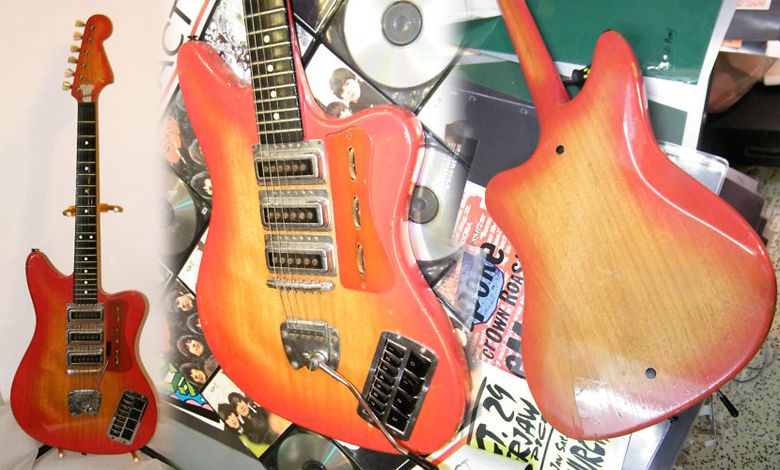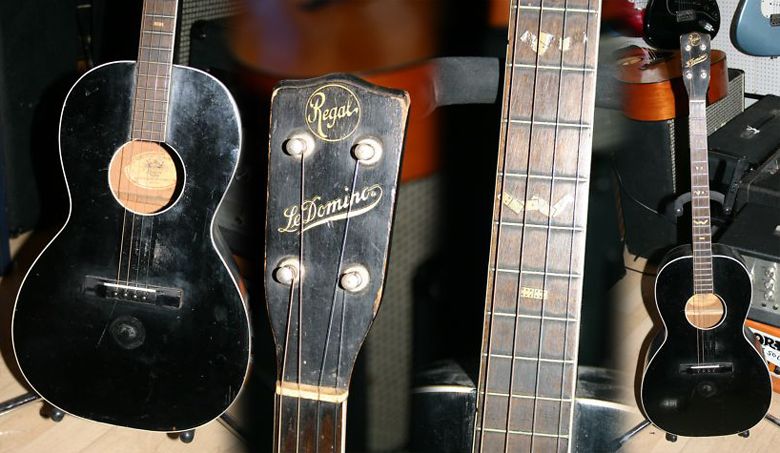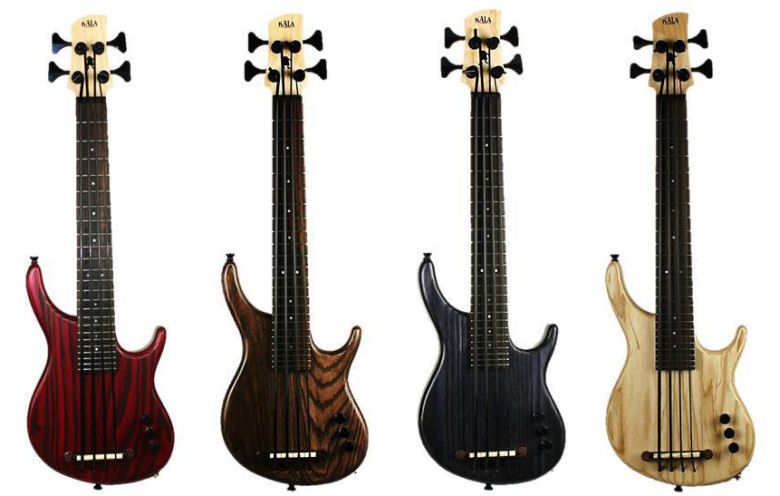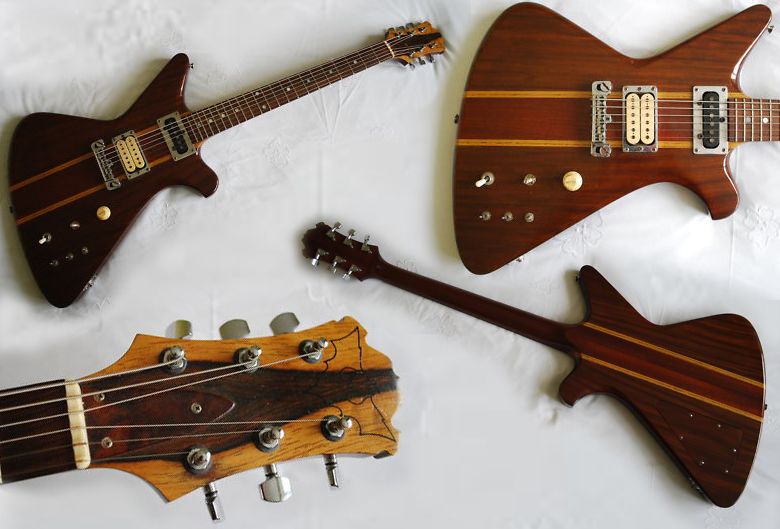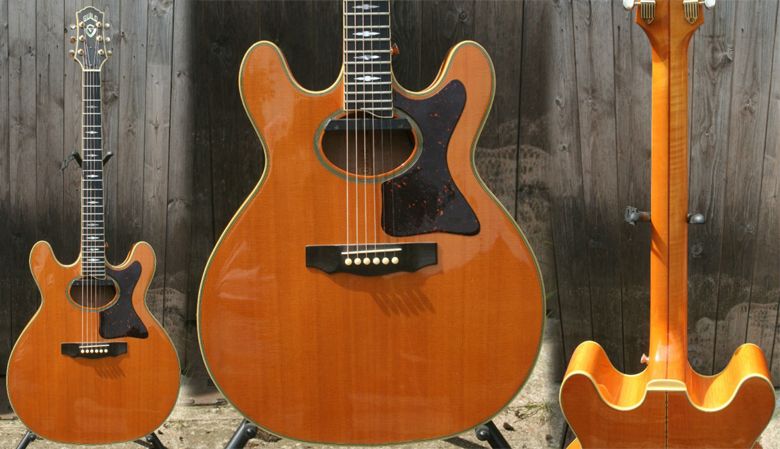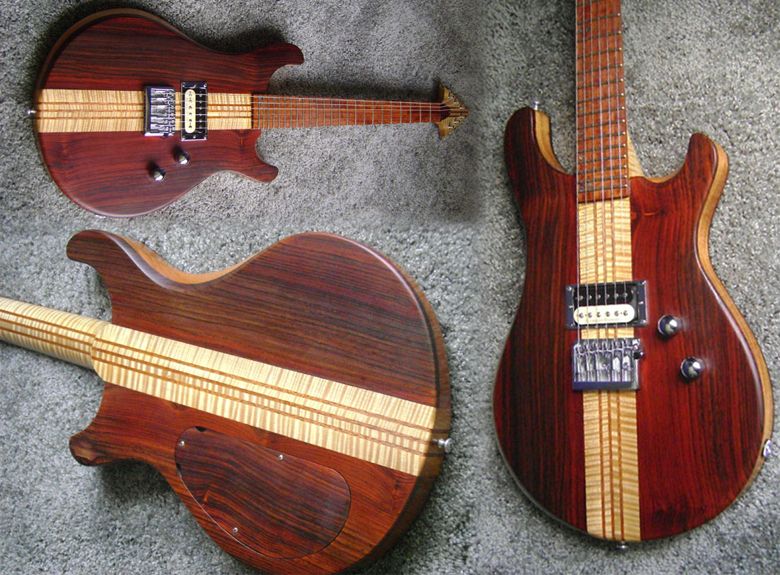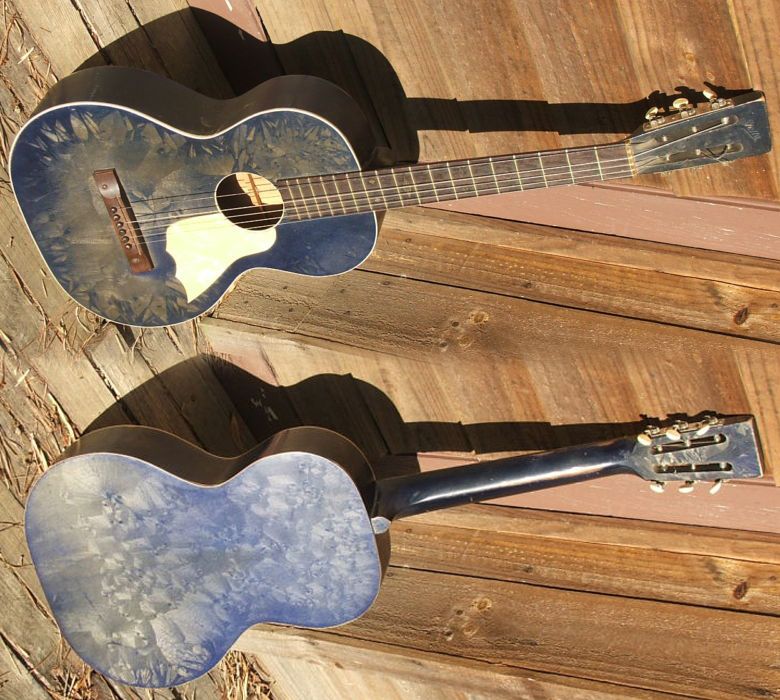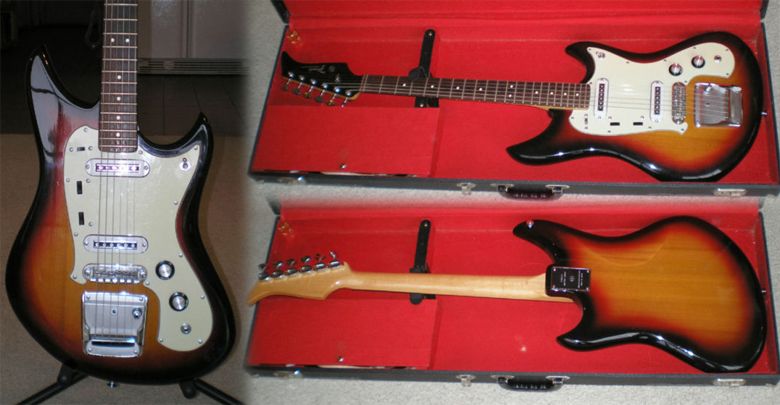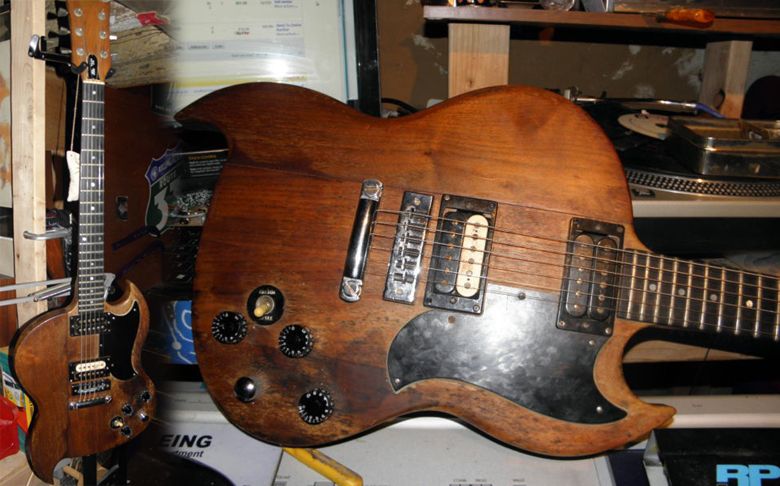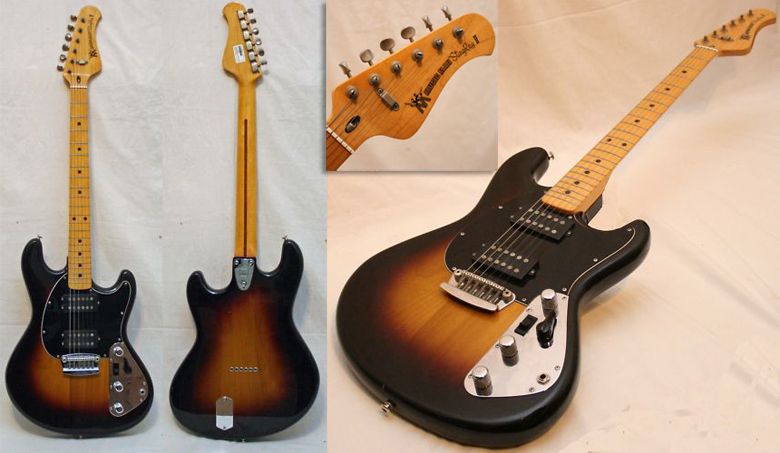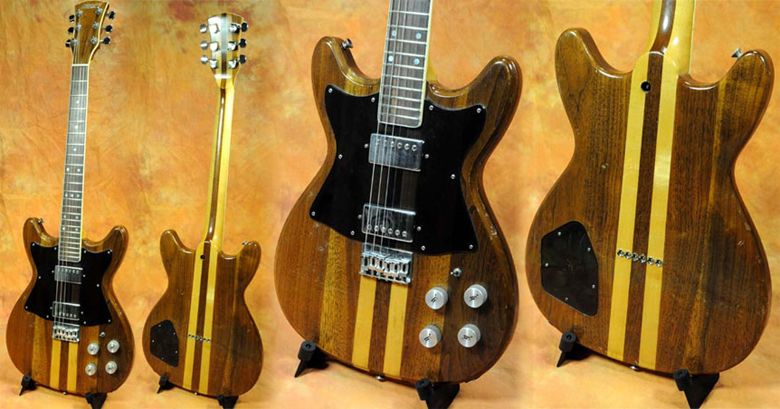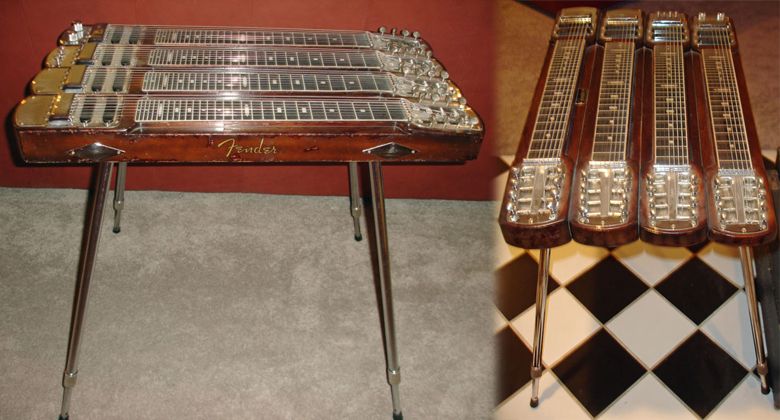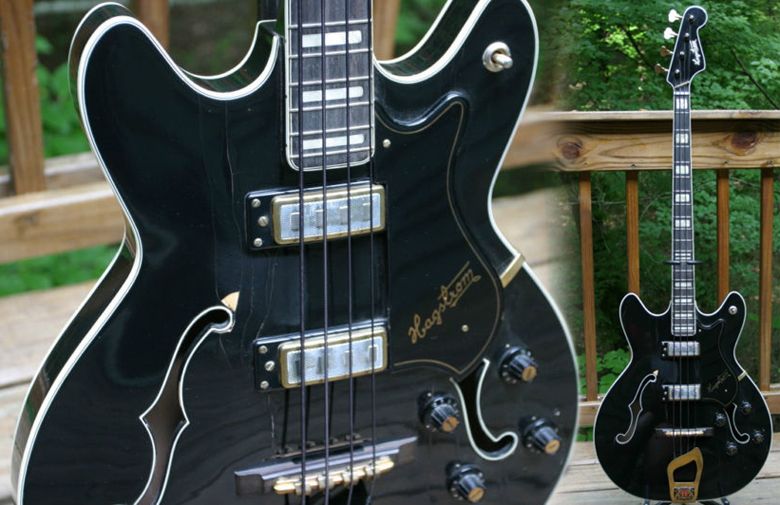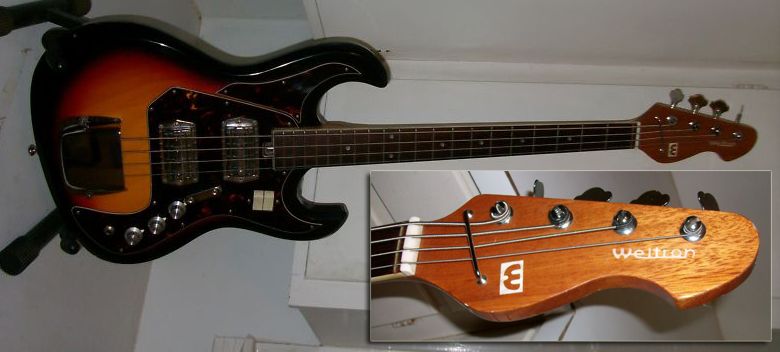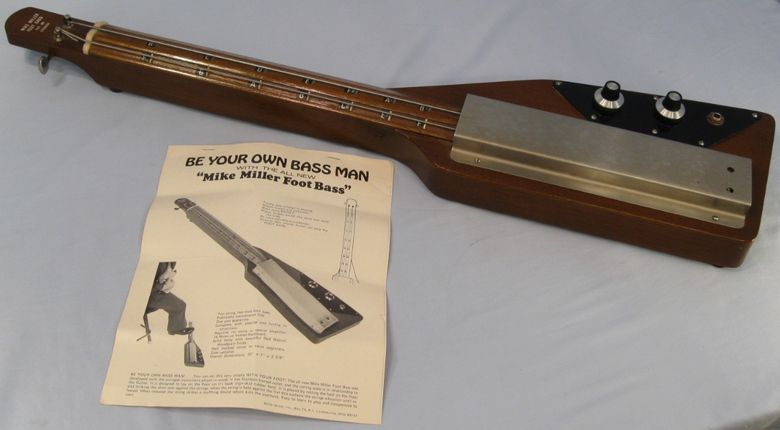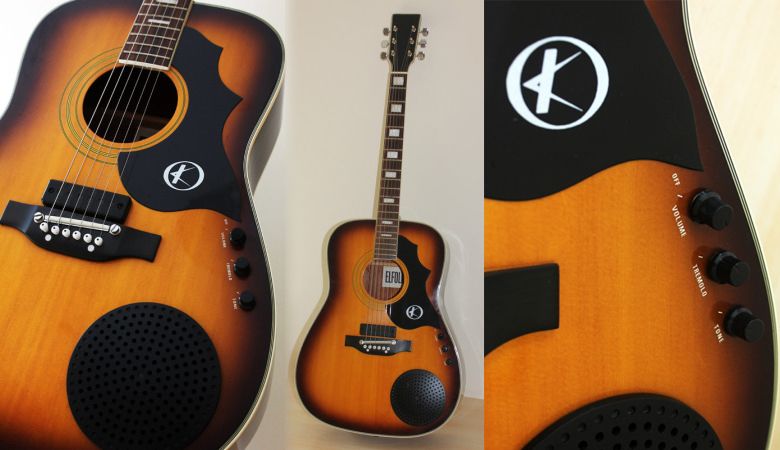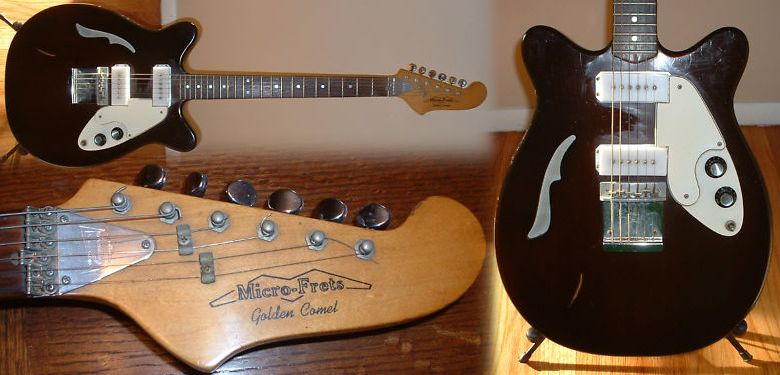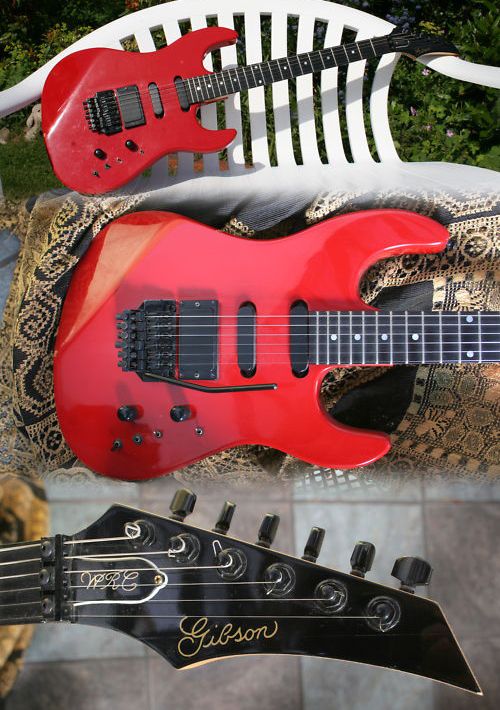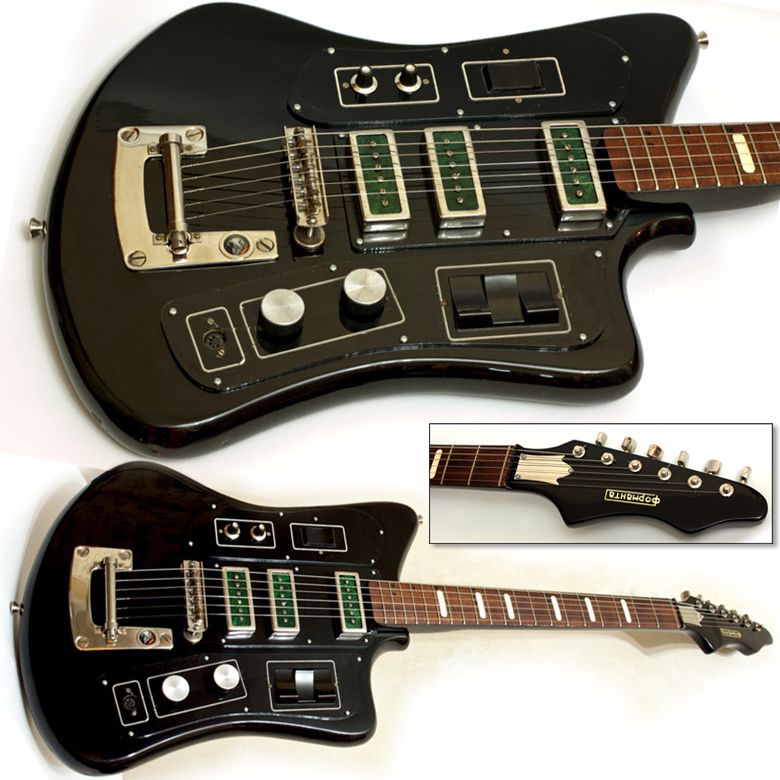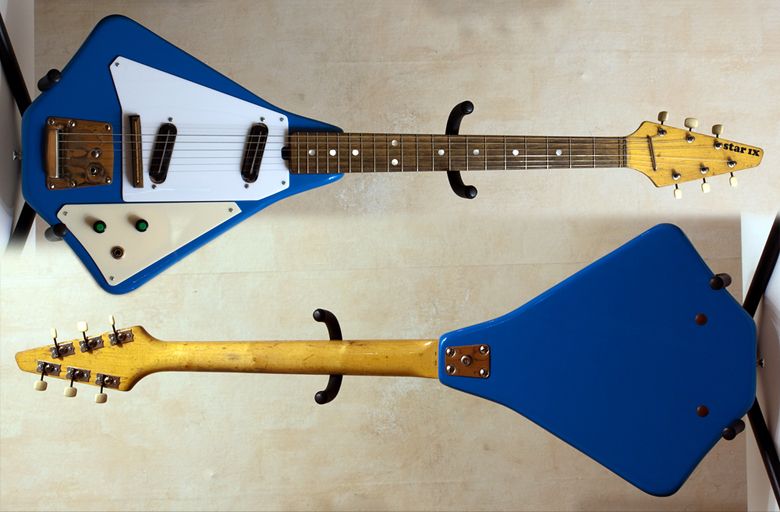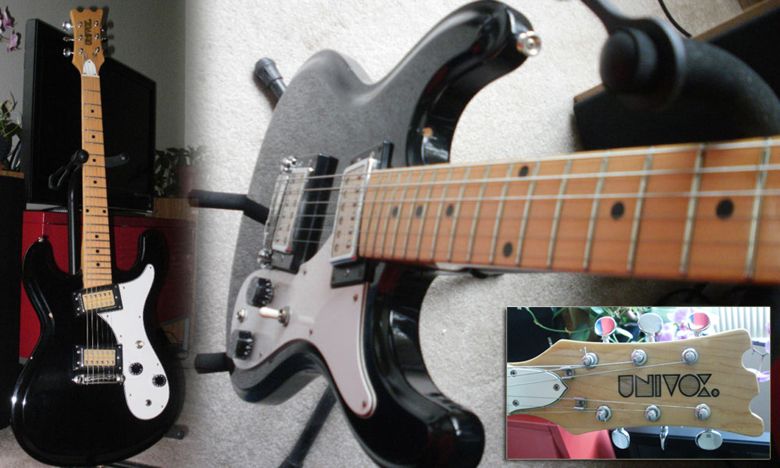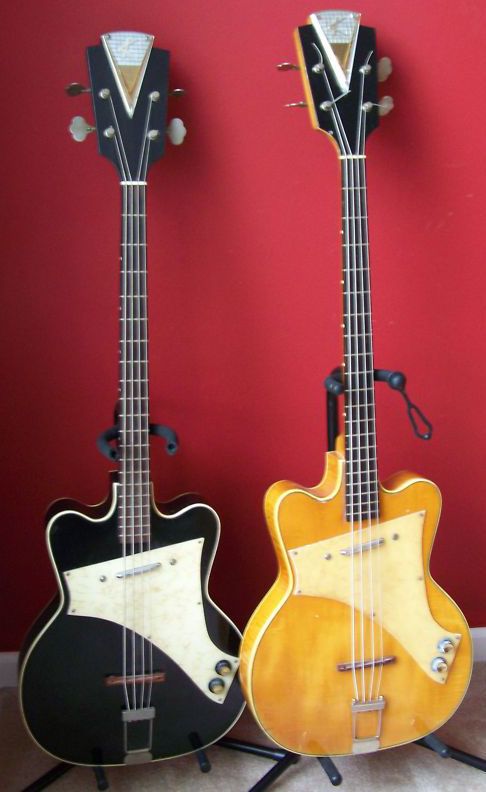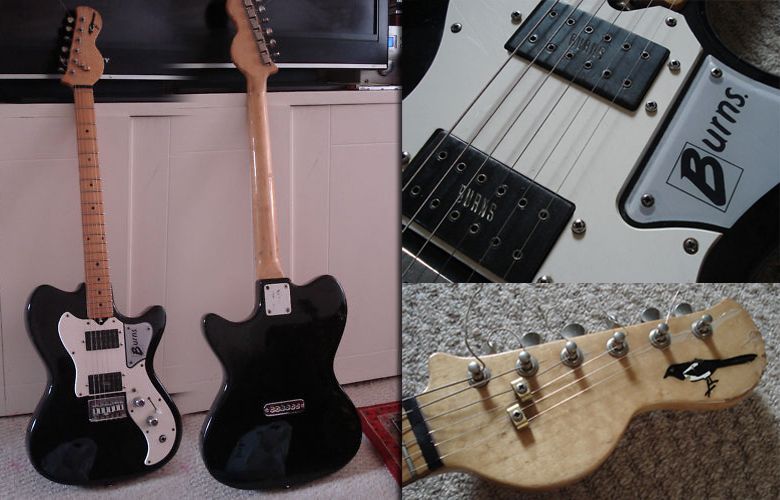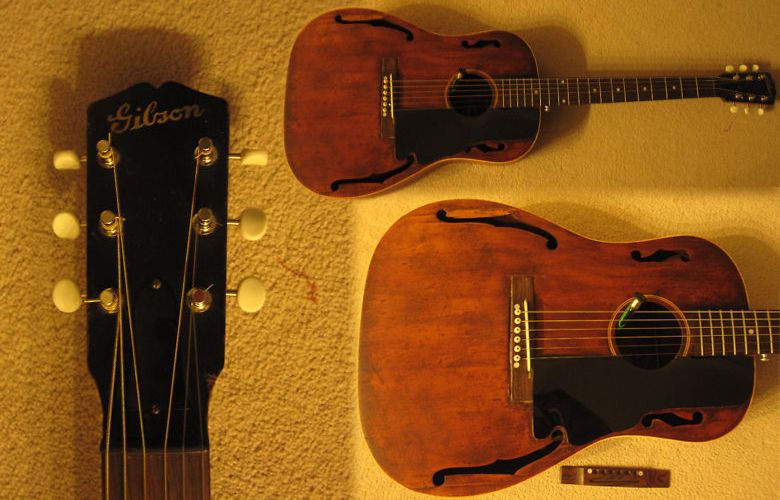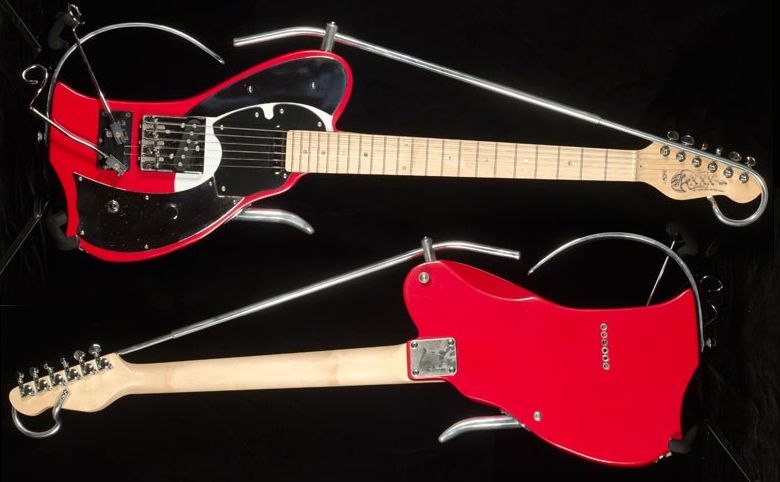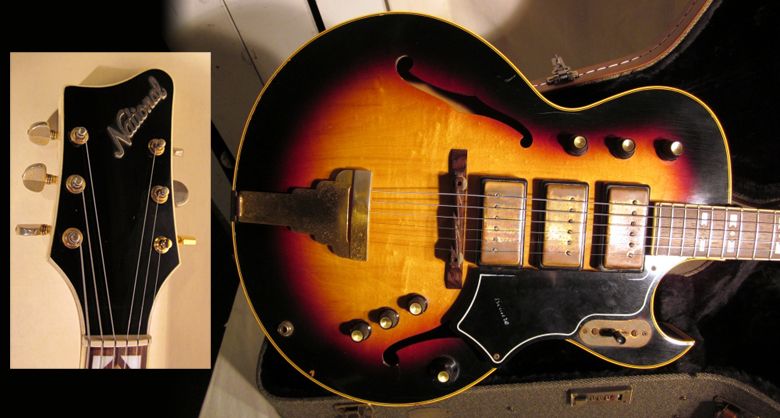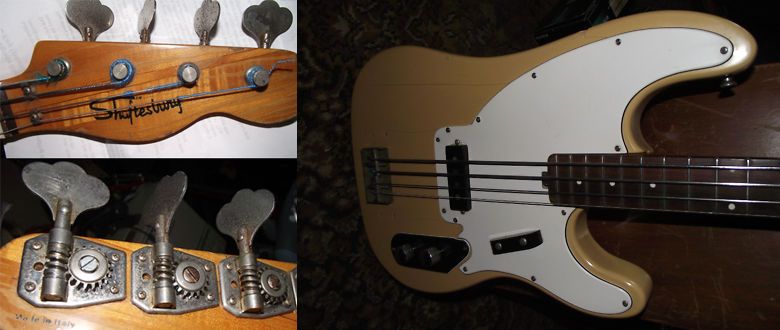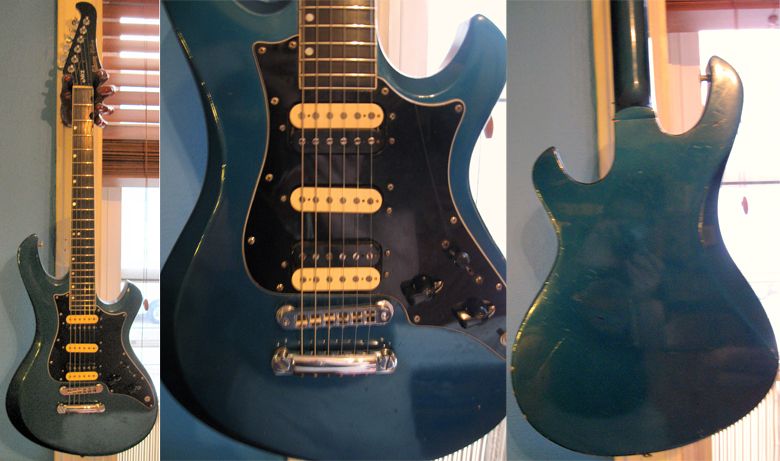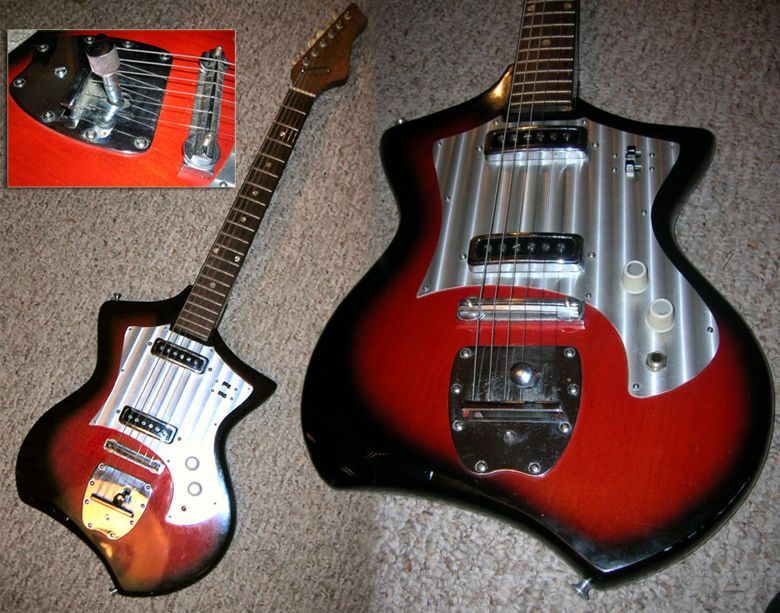DiPinto Belvedere Deluxe with retro good looks to keep your inner Rockabilly Rebel happy!
/
Adorned with lashings of mother of toiletseat, this DiPinto Belvedere Deluxe guitar is highly reminiscent of the weird and wonderful guitars produced in Europe during the 1960s Beat Boom.
Despite its retro looks, it's a modern guitar with modern appointments and playability. The semi-hollow body - beneath all that bling - is of mahogany, whilst the bolt-on maple neck has an ebony fingerboard with star inlays and white binding.
Pickups are a pair of "vintage twang" mini-humbuckers, while a Tune-o-matic bridge and Bigsby vibrato complete the picture.
This guitar is currently being offered for sale on eBay UK with a Buy It Now price of £375.
G L Wilson
© 2011, Guitarz - The Original Guitar Blog - now in its 10th year!
10:46 AM | Labels: cool guitars, DiPinto
Yamaha SG-12 - the holy grail of offset waist guitars, perhaps?
/
Here's another guitar photo plucked from the comments on this blog. The Yamaha SG-2 and SG-3 guitars from 1966-67 are known to be extremely hard to find - not many having made it outside of Japan in this first place - but they are nothing to this, the virtually unknown Yamaha SG-12, the 12-string version of the SG-3.
This example was owned by Guitarz reader "Peer", who said:
I had a 12 string version of the SG-3 once... waaay ubercool! I miss it... it even made me forget how much I hate 12s.I've only seen one of these before pictured in the hands of Eduardo "Gato" Alquinta, singer/guitarist of Chilean folk/rock band Los Jaivas, who actually had his strung as a 6-string.
G L Wilson
© 2011, Guitarz - The Original Guitar Blog - now in its 10th year!
3:31 AM | Labels: 12-string, cool guitars, Japanese guitar, vintage guitars, Yamaha
Kettle Creek guitar by Ethan Harris
/
Currently being offered for sale on eBay with a But It Now price of $850.
G L Wilson
© 2011, Guitarz - The Original Guitar Blog - now in its 10th year!
11:54 AM | Labels: handmade, Kettle Creek, Luthiers
Mutant doubleneck Strat with additional shortscale bass neck somehow shoehorned into place
/
Thanks to Greg Cadman for alerting me to this monstrosity via our Facebook page.
G L Wilson
© 2011, Guitarz - The Original Guitar Blog - now in its 10th year!
1:56 AM | Labels: bass, doubleneck, Hideous guitars, Squier, Stratocaster, weird customisations
1983 San Dimas-era Charvel Star
/
Currently being offered for sale on eBay with a Buy It Now price of $1,625.
G L Wilson
© 2011, Guitarz - The Original Guitar Blog - now in its 10th year!
10:55 AM | Labels: 80s guitars, Charvel, pointy guitar
1967 Eko Kadett bass and more...
/
I have bass version of Kadett - made in '67. Honestly, as far as bass goes, the body is horrible. Neck dives like mad, body is too small, that body 'horn' goes right under your right hand and it hurts :-PSo, it seems that sometimes these vintage quirkily-designed guitars come at a price other than the purely financial; that is to say that if you want to play one you have to compromise and/or upgrade components to make them practical usable instruments.
The neck is pencil-like, strings are floppy, due to short-scale, but overall its nice little funky bass nonetheless :) I did change the bridge, coz original was broken and the tuners (put in some small schaller ones, just like the guitar-ones, but for bass). Here's the pic [see above], bad one, I used phone.
Ryan Waldron also commented about Eko guitars:
From album covers and pictures, I've noticed that EKO guitars seemed to be omnipresent in West Africa in the late sixities and early seventies - they must have been heavily distributed there. Here's a great clip of an orchestra in Mauritania rocking a three Eko line-up:
Thanks for that, Ryan. It's a great clip indeed!
G L Wilson
© 2011, Guitarz - The Original Guitar Blog - now in its 10th year!
6:59 AM | Labels: bass, cool guitars, Eko, Italian guitars, video, vintage guitars, Your Guitars, YouTube
1975 Eko Kadett - one of the finest Italian guitar design
/

Bertram
1:08 AM | Labels: cool guitars, Italian guitars, vintage guitars
Gretsch Model 7264 solidbody from 1979
/
It does look remarkably similar to the Gretsch TK-300 that we looked at in 2008; in fact from the photos alone I can't detect any differences. I'm wondering perhaps if I'd somehow come up with the wrong designation for that one. Are there any Gretsch enthusiasts out there who can enlighten us further?
Anyway, it's a beautiful guitar, and is currently listed on eBay with a starting price of $999 with no bids as I write this and only a day and a half to go before the auction finishes.
G L Wilson
© 2011, Guitarz - The Original Guitar Blog - now in its 10th year!
9:00 AM | Labels: cool guitars, Gretsch, vintage guitars
Dean ML Matt Heafy (from Trivium) Signature with Rising Sun Japanese War Flag Finish (I so love long titles)
/
© 2011, Guitarz - The Original Guitar Blog - now in its 10th year!
1:30 AM | Labels: Dean, Personal Narrative, wacky finishes
Jolana Iris bass - faux thinline Tele bass from 1970s Czechoslovakia
/
This example looks to have been well used and isn't in as good condition as the Jolana Iris guitar we looked at before. Still, it'll appeal to those who like "relics".
G L Wilson
© 2011, Guitarz - The Original Guitar Blog - now in its 10th year!
2:35 AM | Labels: bass, cool guitars, Czechoslovakian guitar, east-European guitar, Jolana, Telecaster, vintage guitars
Höfner 173 and Höfner 173 II
/
Bertram (yes I'm back!)
© 2011, Guitarz - The Original Guitar Blog - now in its 10th year!
9:25 AM | Labels: German guitars, Hofner, vintage guitars
Halo Guitars "The Reaper"
/
Joking aside, it's a Halo Reaper guitar with solid mahogany body, flamed maple veneer, transparent green finish, Halo humbuckers, and Floyd Rose Special trem, and it's currently listed on eBay with a very reasonable Buy It Now price of $299.
I've had Halo Guitars as a friend on my MySpace page for years now (not that I use MySpace any more... Why did they have to spoil it by trying to imitate Facebook?) and whilst they produce a number of exciting designs suited to the metal player, they also turn out the occasional beauty that others of us can appreciate too. Long-term Guitarz readers may recall that I blogged about the Halo Violon back in 2007.
G L Wilson
© 2011, Guitarz - The Original Guitar Blog - now in its 10th year!
1:32 AM | Labels: Halo Guitars, Weird guitars
Floyd Rose Redmond Series USA Speedloader
/
I'm not sure how easy the Speedloader strings are to come by, but this seller on eBay is including five sets along with the guitar which could last you a while, depending of course on how long a set of strings lasts you! This guitar is currently available on eBay for the Buy It Now price of $1,000.
G L Wilson
© 2011, Guitarz - The Original Guitar Blog - now in its 10th year!
11:53 AM | Labels: Floyd Rose, headless, Stratocaster
Galveston B.B. Stone: ERiC AiXeLsyD's "square guitar"
/
We've looked at the Galveston brand on this blog before, but alas have never really found out very much about it.
This "square guitar", almost like a Bo Diddley rectangular guitar with cutaways, is called the Galveston B.B. Stone and is owned and played by Guitarz reader Eric.
He tells us that:
B.B. Stone is apparently a Korean blues artist and guitar-builder, and he designed the guitar with Jerker Antoni of Sweden’s Eagle Instruments. There are 24 pieces worldwide, the ones around the world are branded with the groovy Eagle headstock.For more, please see Eric's own blog. He has also made a website for the Square Guitar.
G L Wilson
© 2011, Guitarz - The Original Guitar Blog - now in its 10th year!
6:02 AM | Labels: cool guitars, galveston, Weird guitars, Your Guitars
A Swedish surf guitar! The Hagström Futurama Coronado Automatic
/
As you can see it takes its shape from the Fender Jazzmaster/Jaguar but the controls are very "European". The head too is very Fender-esque, but unlike any Fenders of the period the guitar is of through-neck construction.
This example is currently listed on eBay with a starting price of £600 and just over a day to go before the auction ends (as I type this).
G L Wilson
© 2011, Guitarz - The Original Guitar Blog - now in its 10th year!
11:21 AM | Labels: cool guitars, Hagstrom, Jaguar/Jazzmaster, Swedish guitars, vintage guitars
Washburn Bantam doubleneck headless bass with fretted and fretless necks
/
If my memory serves me correctly this model was played back in the day by German session bassist Frank Itt.
The pictured example (thought to be one of only six imported into the UK) is currently being offered for sale on BassGear.co.uk priced at £750.
Thanks to Marky for bringing this instrument to my attention.
G L Wilson
© 2011, Guitarz - The Original Guitar Blog - now in its 10th year!
2:14 AM | Labels: 80s guitars, bass, cool guitars, doubleneck, fretless, headless
1930s Regal Le Domino tenor parlour guitar
/
The Regal Musical Instrument Company, established in 1908 in Chicago, are perhaps best known today for their production of resonator guitars from their first development up until 1941. They produced components and bodies for both National and Dobro guitars and by the 1930s were one of the largest manufacturers of musical instruments in the world.
G L Wilson
© 2011, Guitarz - The Original Guitar Blog - now in its 10th year!
2:38 PM | Labels: acoustic, Regal, Tenor guitar, vintage guitars
The Kala U-Bass solidbodies are available at last
/
I think the main thing that might put off bass players is the size of it - or should I say, "lack of size". Some might think they'd look a little silly playing one of these, as if they were playing a toy, but I'd say approach the instrument with an open mind.
G L Wilson
© 2011, Guitarz - The Original Guitar Blog - now in its 10th year!
Made in UK mystery guitar - any ideas what this is?
/
Does anyone have any clue as to the guitar's identity? The shape reminds me slightly of that of Scotland's own Egypt Guitars, but the bat logo on the headstock would suggest otherwise. Any ideas?
G L Wilson
© 2011, Guitarz - The Original Guitar Blog - now in its 10th year!
12:11 PM | Labels: UK guitars, What's that guitar?
Guild Studio 24 double cutaway 24-fret acoustic guitar
/
This guitar is currently being auctioned on eBay UK with a starting price of £2,750.
G L Wilson
© 2011, Guitarz - The Original Guitar Blog - now in its 10th year!
2:10 AM | Labels: 80s guitars, acoustic, cool guitars, Guild, innovations
Adam's hand-built cocobolo electric guitar
/
The shape is a litte PRS-ish - well at least around the double cutaway end of the body, especially with that little scoop on the lower horn to aid access to the top frets, and I freely admit that I am no PRS fan. I think also that the headstock looks a little over-large for the body shape... but these are minor quibbles and my own opinion to boot. I'm not trying to knock the guitar at all. As I was saying, I wish I had it in me to be able to create a guitar from scratch. This looks to be a beautifully constructed and finished instrument, with top notch attention to detail.
Anyway, the specs:
- 25" scale neck with jumbo frets.
- 12" radius fretboard.
- Gotoh vintage/modern tuners (vintage style, modern 18:1 gear ratio)
- Black TUSQ nut (self lubricating and sounds great)
- Neck thru design.
- Figured Bubinga fretboard with offset abalone dot inlays. (side dots are abalone too)
- AAAA Flamed maple neck with thick mahogany laminates. (adds strength...and looks cool)
- Semi-gloss finish on neck; satin finish on body.
- (Paper thin finish! Resonates better by far than those 1/8" thick factory finishes on the import guitars.)
- KING Grade cocobolo tops and bottoms. 1/4" thick for both sets. Museum grade wood.
(cocobolo is most closely related tonally to Brazilian Rosewood with many claiming Cocobolo is superior tonally) - Seymour Duncan JB humbucker.
(most versatile humbucker around...everyone from jazz cats to metal heads love the JB) - Cocobolo control plate and truss rod cover.
- 500k volume and tone pots.
- Schaller Roller bridge.
(hands down the most adjustable hardtail bridge on the market. Heavy too. GREAT sustain!) - Hair under 9 lbs in total weight
G L Wilson
© 2011, Guitarz - The Original Guitar Blog - now in its 10th year!
12:45 PM | Labels: handmade, Luthiers, one-offs, Your Guitars
1930s Stella parlour guitar in crystalline blue finish
/
The Stella brand, as well as other Oscar Schmidt brands Sovereign and La Scala, was acquired by the Harmony Company of Chicago, Illinois in 1939.
Pictured above we see a 1930s Stella parlour guitar in a rare crytalline blue finish, created using "a technique that has been lost with time". Finishes were more commonly black, natural or sunburst. This is one of the later Oscar Schmidt Stellas and pre-dates the Harmony takeover.
Unfortunately, this particular example is not in very good condition and would require the attention of a luthier to make it playable.
G L Wilson
© 2011, Guitarz - The Original Guitar Blog - now in its 10th year!
2:35 AM | Labels: acoustic, cool guitars, Stella, vintage guitars, wacky finishes
Diego's Stocco's Experibass - 4 necks on a double bass
/
I had an idea in mind for an instrument I wanted to build. My curiosity was to hear the sound of violin, viola and cello strings amplified through the body of a double bass. I came up with a quadruple-neck experimental "something" that I thought to call Experibass.While the music produced is mostly percussive, there's no denying the drama within it.
To play it I used cello and double bass bows, a little device I built with fishing line and hose clamps, a paintbrush, a fork, spoons, a kick drum pedal and a drum stick. I hope you'll like it!
For more, see www.behance.net/Gallery/ExperibassHans-Zimmers-Score-for-Sherlock-Holmes/366637
G L Wilson
© 2011, Guitarz - The Original Guitar Blog - now in its 10th year!
5:08 AM | Labels: bass, double bass, multi-neck, not guitar, one-offs, video, weird customisations, YouTube
Rare Yamaha SG-2 circa 1966-67 on eBay now!
/
It sure is a nice one. Don't you think it'd be a good companion for my SG-3? Anyway, Guitarz has linked through to hundreds - possibly thousands - of eBay auctions over the years. It's nice to see an eBay auction linking to us for a change!Yamaha SG-2 SG 2 their first electric guitar 60's MOJOOne of the coolest sexist guitars you will ever see. From the 60's when guitars were COOL. Yamahas first eclectic guitar. Cooler looking than a Strat.Check out Link Ray playing his on youtube playing midnight lover http://www.youtube.com/watch?gl=US&feature=related&hl=iw&v=-zBhViJYO9MAnd this site loves them http://guitarz.blogspot.com/2010/04/yamaha-sg-3-like-link-wrays-guitar-but.htmlHigh quality guitar, check out Harmony Central for the user reviews.Guitar looks great with just a small chip on the bottom, see pic.Plays well and electronics work, sounds great, could probably use some contact cleaner,Output jack may need to be tightened or cleaned or looked at as it crackles if you move the cord.Comes with the whammy bar.Comes with a guitar case that is not the greatest but works well.
(sic throughout)
This guitar was listed with a starting bid of $25.01 and bidding has already been enthusiastic with over 5 days left to go on this auction. I'd love to bid myself, but it would be incredibly hard to justify buying another guitar right now especially one so similar to a guitar I already own.
G L Wilson
© 2011, Guitarz - The Original Guitar Blog - now in its 10th year!
3:30 AM | Labels: cool guitars, vintage guitars, Yamaha
Bob Mothersbaugh's Les Paul with "droopy" lower horn
/
The previous blog post reminded me of this - another Gibson guitar with a part of the body sliced off and reversed. The photo shows Bob Mothersbaugh in the video for Devo's "Whip It" with a very peculiar-looking Les Paul.
Bob tells the story of this guitar in this Premier Guitar magazine interview:
With all the technology being dangled in your face when you hit it big, did you ever use a guitar synthesizer?Read the full interview here.
Back in 1979, I used a device made by 360 Systems. It was a big box that sat next to your amp and required a special pickup. The 360 Systems people recommended I use a Les Paul, and at the time I was horrified—I thought Les Pauls represented arena rock, long hair, and Puka shells. But I got a Les Paul and took a jigsaw to it with the intention of making it look like a skull. I cut the little horn off at the cutaway and flipped it over backwards and thought it looked a lot better. The 360 was a horrible synth and really didn’t sound good. I only used it for one tour.
G L Wilson
© 2011, Guitarz - The Original Guitar Blog - now in its 10th year!
3:56 PM | Labels: Devo, Gibson, Les Paul, weird customisations
1979 Gibson "The SG" with partially reversed body!
/
Gibson's "The SG" was a partner to "The Paul"; both were walnut-bodied budget-conscious versions of Gibson's two best-loved solidbody designs and were produced between 1978-1982.
Thanks to Colin Brown who suggested we look at this guitar via our Facebook page.
G L Wilson
© 2011, Guitarz - The Original Guitar Blog - now in its 10th year!
2:07 PM | Labels: Gibson, SG, weird customisations
Andrei's doubleneck and 7-string guitars
/
© 2011, Guitarz - The Original Guitar Blog - now in its 10th year!
12:18 PM | Labels: 7-string, classical, doubleneck, fretless, nylon string guitar, video, Weird guitars, YouTube
Music Man Stingray II guitar from 1977
/
I am also reminded of the more basic G&L SC-2, another of Leo Fender's post-Fender designs, Leo's own G&L company being founded in 1979 with old friends and ex-Fender colleagues George Fullerton and Dale Hyatt.
G L Wilson
© 2011, Guitarz - The Original Guitar Blog - now in its 10th year!
3:32 AM | Labels: cool guitars, Music Man, vintage guitars
Gretsch Committee 7628 solidbody circa 1978
/
Currently being offered for sale on eBay with a Buy It Now price of $1,119.99, this is actually priced much more cheaply than some other examples I have seen.
[* OK, so before anyone comments, I know that many Gretsches are Bigsby-less and there are all the "Jet" series of solidbodies, but the hollowbody Bigsby-equipped Gretsch beloved of rockabilly and rock'n'roll artists is probably the popular image that most people conjure up when they hear the name Gretsch.]
G L Wilson
© 2011, Guitarz - The Original Guitar Blog - now in its 10th year!
12:09 PM | Labels: cool guitars, Gretsch, vintage guitars
Another acoustic guitar with a built-in speaker in its top
/
A few days ago here on Guitarz we looked at a Kay acoustic guitar with built-in amp, speaker and effects. Well, here's something similar submitted by Jonny M. Garcia via our Facebook page but this time it's not a factory-fitted speaker, it's a Do It Yourself conversion by the owner who is now selling the guitar on Craig's List. This is what he says about it:
I modified an almost new AmericanLegacy acoustic guitar by mounting a speaker and amp (with overdrive) directly into the guitar! I quickened the action and now this bad ass mother sounds, plays and feels like a strat! A guitar body is really a speaker box and the speaker here picks up on resonant frequencies that feeds back on itself like Eddie Van Halen! It is truly a live wire! It uses 2- 9 volt batteries, and has a 3 band EQ onboard as well. The pickup is a transducer. The frets are in perfect shape. It comes with a hard case. Look closely at the pic to see the red "on" light next to the volume and overdrive controls. Take it to an acoustic jam anywhere and you can play rock leads on an acoustic that really sound like rock leads! I made one for myself nearly 30 years ago and it has been awesome and reliable, and people are amazed! I am a furniture artisan so my workmanship is good. Believe it or not, this is the second one I've made in all that time- this one's for sale!I don't know where to start! "Plays and feels like a Strat"? "Eddie Van Halen"? "Overdrive control"? I do have to ask, WHY? If you want something that plays and feels like a Strat, why not use a Strat? As for using an acoustic to play rock leads, again I do not see the point. Just because something is possible, it doesn't necessarily follow that it should be done.
Also, I can't help thinking that cutting a hole in an acoutic's top and inserting a speaker is not going to do the natural acoustic sound of the guitar any favours at all. And what about the internal bracing? I can't believe he cut a hole without cutting through some of that.
G L Wilson
© 2011, Guitarz - The Original Guitar Blog - now in its 10th year!
4:33 AM | Labels: acoustic, American Legacy, on-board amps, weird customisations
Fender Stringmaster console guitar, 4 x 8-string necks = 32 strings!
/
With 4 necks, 32 strings and 8 pickups, here we have a Fender Stringmaster also know as the Quad or Q-8. The eBay seller claims it is from the 1940s or 1950s, but a little basic research would have revealed that the Stringmaster was first introduced in 1953, so all this talk of "1940s" is lazy unsubstantiated guesswork.
This particular example has 22.5" scale necks. Stringmasters were also available with 24.5" scale necks, although in their first year of production a long 26" scale was used.
The Stringmaster was available in two, three and four-neck versions. The single-neck equiavalent was known as the Fender Deluxe and was available in 6 and 8-string variants.
Currently being auctioned on eBay with a starting price of $1,999.99.
G L Wilson
© 2011, Guitarz - The Original Guitar Blog - now in its 10th year!
8:38 AM | Labels: console guitar, Fender, multi-neck, Steel guitar, vintage guitars
May Bell faux resonator guitar from 1935
/
G L Wilson
© 2011, Guitarz - The Original Guitar Blog - now in its 10th year!
12:44 PM | Labels: acoustic, May Bell, vintage guitars, Weird guitars
1968 Hagström Concord DeLuxe semi-hollowbody bass
/
Although finished in black, this Hagström Concord DeLuxe bass would make an ideal partner for such a guitar. This model bass was orignally named the Viking, just like its guitar sibling, but for some reason best known to Hagström it was renamed the Concord. There were two models: the C-1 with two single coil pickups, bound (front and back) hollowbody, dot inlays on the neck, and chrome-plated hardware; and the C-2 or DeLuxe - as we see pictured here - with similar attributes as the C-1 but with bound f-holes, bound neck with block inlays on the fingerboard, and gold-plated hardware. The C-1 was in production from 1965-1971 with 2749 examples being built, whereas the DeLuxe version is much rarer having been produced between 1967-1968 with only 150 examples being built.
Interestingly, Hagström listed both models as being available with Mahogany sunburst, Golden mahogany sunburst, and cherry red finishes. No mention is made of black, so possibly the example we see here has been re-finished, or else - as the seller suggests - this is a very rare custom finish making this bass even more unusual.
In 1968 the DeLuxe would have cost $435 (against the C-1's $285). Now in 2011, the above-pictured example is currently being auctioned on eBay and the bidding is currently (as I type this) at the 1968 price for the C-1 model, although there is a a reserve that hasn't yet been met. It'll be interesting to see what this sells for.
G L Wilson
© 2011, Guitarz - The Original Guitar Blog - now in its 10th year!
6:35 AM | Labels: bass, cool guitars, Hagstrom, semi-hollow body, vintage guitars
1960s Japanese Weltron-branded short-scale bass guitar
/
Very rare 1960s Weltron bass made in Japan. No images on the net; very little info or references to Weltron guitars, period. No references I've found to Weltron basses. What little info there is available states "Weltron" branded guitars were imported by either the Weltron Co. of Danville, VA, or Womack Electronics of Goldsboro, NC, so these are privately branded Japanese imports - probably made by Matsumoku and definitely a cut above many imports from the same time period. (Note: I did hear from another eBayer who has an identical bass branded "Vargas").There's no evidence for the Matsumoku connection. It's possible but I wouldn't say probable. This, I fear, is a case of an eBay seller's "spin" and shouldn't be taken as 100% accurate fact. You really do need to be able to read between the lines when checking out items for sale on eBay, as there is so much BS written by sellers.
Anyway, the bass itself is interesting. It would appear from the photos to be ultra-short scale, i.e. similar to a guitar's scale length, and design-wise owes a thing or two to Burns. It appears to be in very good condition, but the Buy It Now price of $289 is right at the top end of what I personally would be prepared to pay were I in the market for such an instrument.
G L Wilson
© 2011, Guitarz - The Original Guitar Blog - now in its 10th year!
8:00 AM | Labels: bass, Japanese guitar, vintage guitars, Weltron
The Mike Miller footbass - play 2-string bass with your feet while you play guitar!
/
I'll let the text from the original instruction booklet (seen in the photo) tell you all about it:
BE YOUR OWN BASS MAN
With the all new
"Mike Miller Foot Bass"Totally new concept in playing.Amaze friends and audiences.Make extra MONEY.Makes singles sound like duos and duos like trios.Be more valuable as a sideman.Anyone who chords Guitar can play the FOOT BASS.Two string, two level foot bass.Practically maintenance free.One year guarantee.Complete with playing and tuning instructions.Requires no extra or special amplifier.14 Notes on fretted footboard.Solid body with beautiful Red Walnut Woodgrain finish.Well marked notes to assist beginners.Case optional.Overall dimensions: 31" x 7" x 2 5/8"BE YOUR OWN BASS MAN!... You can do this very simply WITH YOUR FOOT! The all new Mike Miller Foot bass was developed with the stringed instrument player in mind. It has fourteen fretted notes, and the noting scale is in relationship to the Guitar. It is designed to lay on the floor on its back (non-skid rubber feet). It is played by resting the heel on the floor and striking the shoe sole against the strings, when the string is held against the fret this sustains the strings vibration until released. When relesed the string strikes a muffling device which kills the overtone. Easy to learn to play and inexpensive to own.
G L Wilson
© 2011, Guitarz - The Original Guitar Blog - now in its 10th year!
4:01 PM | Labels: bass, Mike Miller, minimalist guitars, vintage guitars, Weird guitars
1970s Kay acoustic with built-in amp and FX
/
It's so bizarre that it's almost desirable!
G L Wilson
© 2011, Guitarz - The Original Guitar Blog - now in its 10th year!
3:11 PM | Labels: acoustic, Kay, on-board amps, Weird guitars
Micro-Frets Golden Comet
/
The above-pictured guitar is a Micro-Frets Golden Comet (Micro-Frets often had space-age names). This is quite a basic model without the Micro-Frets Calibrato (a vibrato which allowed the strings to stay in tune relatively while the pitch was being altered) but nevertheless is still a much desirable model. It is of semi-hollow body construction with distinctively shaped f-hole and features pickups desgined by Bill Lawrence and which look decidedly P90-like.
This Golden Comet is currently being auctioned on eBay with the starting price set at a quite reasonable $500.
For more about Micro-Frets guitars see their official website at: www.microfrets.com
G L Wilson
© 2011, Guitarz - The Original Guitar Blog - now in its 10th year!
9:01 AM | Labels: cool guitars, innovations, Micro-Frets, semi-hollow body, vintage guitars
Maton Gold Line 750 - vintage Australian guitar from 1962
/
The guitar we see pictured above is a Maton Gold Line 750. It is of set-neck construction with a slab body featuring a German carve appropriately - given the model name - picked out in gold. Apparently only 210 examples of this model were built between 1962-1963, before the design evolved into the better-known Maton Fyrbyrd.
This guitar is in superb condition and is currently being offered for sale on eBay with a Buy It Now price of $5000 (US Dollars).
For more on Maton and other guitars from down under, see Australia's own always excellent guitarnerd blog.
G L Wilson
© 2011, Guitarz - The Original Guitar Blog - now in its 10th year!
5:46 AM | Labels: Australian guitar, cool guitars, Maton, vintage guitars
Gibson WRC - a superstrat from Gibson with assistance from Wayne Charvel
/
Recently here on Guitarz we've been discussing and looking at Gibson guitars with Fender influences (see here and here).
Pictured here we see a Gibson WRC, and there's absolutely no denying its Strattiness. Despite carrying the Gibson name, these were actually built by Wayne Charvel (his initials are W.R.C.) in 1987-1988. It's ironic in a way when you consider that Charvel is now part of the Fender empire. It's like some things come full circle.
In tried and tested Superstrat tradtion, the WRC is equipped with a Floyd Rose double locking trem. It has three pickups in SSH formation with a coil tap for the humbucker and individual toggles for each pickup allowing for a wider range of pickup combinations than the usual 5-position switch. In keeping with Fender-derived guitars it has a bolt-on neck, which is of the pointy headed variety as was the fashion when this guitar was made.
This guitar is currently being auctioned on eBay UK with a starting price of £795.
G L Wilson
© 2011, Guitarz - The Original Guitar Blog - now in its 10th year!
12:11 PM | Labels: 80s guitars, Charvel, Gibson, superstrat
1960s vintage Japanese Givtone "baritone" guitar
/
The Givtone name is almost certainly a department store/catalogue brandname. The seller rather lazily refers to this guitar as probably being a Teisco as if they were the only producers of Japanese electric guitars in that period. I'd say it looks more like a Zen-on/Zenon or Morales, maybe even Kawai or Guyatone, although I concede that the neck does look Teisco-like with its very narrow fretwire (maybe just a fashion of the era), but other Teisco trademarks such as offset block fingerboard inlays and striped metal pickguard are absent.
As, to it being a baritone, I feel this is unlikely. The seller states that:
Guitars like this, with a 26.5" scale, are usually tuned to Low "B" in between a guitar and bass but it'll hold up if you want to go lower or even higher.Well, as I've said before, my understanding is that "baritone" tunings somewhere between a guitar and bass are a relatively modern concept. On a vintage guitar such as this, they'd more likely be tuned down a whole octave a la Bass VI. However, for a Bass VI, I would have expected a slightly longer scale length, maybe 28" or preferably 30". I have to wonder if this was simply a long scale guitar intended for regular tuning?
By the way, the earliest reference I can find to baritone guitars being used is in the Wikipedia entry for the Fender Bass VI, which says:
In the late 1960s some artists used heavy guitar strings with resp. length and tuned the Bass VI to a baritone guitar from 'B to b' or 'A to a'. With this 'down and dirty' sound the Fender VI enriched 'Indo-Rock' bands with their unique Rock & Roll sound. One of those players was Reggy Tielman from the 'Tielman Brothers'.Note that whilst these guys were using baritone tunings, the instrument they were using was built as a Bass VI.
Just to confuse things, the Wikipedia entry for "baritone guitar", states that:
The Danelectro Company was the first to introduce the electric baritone guitar in the late 1950s, and the instrument began to appear in surf music, as well as background music for many movie soundtracks, especially spaghetti westerns.The confusion comes in here because the modern name "baritone guitar" is being applied retrospectively to the Bass VI, the term being incorrectly used here so as to distinguish the original six-string bass from the modern variant typically with a low B string and high C string, 34" scale and proper bass string spacing.
But maybe you know different and there was an earlier precedent for dedicated baritone guitars being made in the 1960s. Because of the mixed terminology being used it is very difficult to find out the absolute truth of the matter.
G L Wilson
© 2011, Guitarz - The Original Guitar Blog - now in its 10th year!
4:08 AM | Labels: baritone guitar, bass VI, cool guitars, Givtone, Japanese guitar, vintage guitars
Soviet-era USSR B&G Formanta fuzz guitar
/
This guitar is currently being offered for sale on eBay with a Buy It Now price of $400. The seller tells us that it was made in the 1980s in the USSR by Belarusian Musical Instruments Factory at Borisov city, and that it has a built-in fuzz effect powered by a 9 volt battery. Apparently the headstock shape is rare for this model and has a reversed signature.
G L Wilson
© 2011, Guitarz - The Original Guitar Blog - now in its 10th year!
3:46 PM | Labels: 80s guitars, cool guitars, effects, Russian guitars, Weird guitars
1970s Czechoslovakian Jolana Star IX guitar a.k.a. the Screwdriver
/
This guitar is currently being auctioned on eBay with a starting price of $200.
For more about Jolana guitars, see Cheesy Guitars!
G L Wilson
© 2011, Guitarz - The Original Guitar Blog - now in its 10th year!
8:25 AM | Labels: Czechoslovakian guitar, east-European guitar, Jolana, Weird guitars
Univox Hi-Flier from 1976 - Japanese-made Mosrite copy
/
I thought this was kind of neat, with a maple fingerboard, wraparound bridge, and humbuckers... I've only seen the ones with the jazzy trem, rosewood fingerboard, and single coils.The guitar in question is a Univox Hi-Flier, which is essentially a 1970s Japanese-made copy of the Mosrite Ventures model. Nirvana's Kurt Cobain helped popularise these old Univox Mosrite copies, injecting them with the cool factor.
This example is currently being offered for sale on eBay with a starting bid of $300.
G L Wilson
© 2011, Guitarz - The Original Guitar Blog - now in its 10th year!
2:56 PM | Labels: cool guitars, Japanese guitar, Mosrite, Univox, vintage guitars
A pair of 1950s Kay Jazz Special basses
/
Here we have a pair of Kay Jazz Special basses from the 1950s. With their hollowbody design they are a close relation to the Kay Thin Twin Bass we looked at here on Guitarz last month, the main differences being the doublecutaway body shape, pickguard, and the over-sized headstock with Art Deco styled "Kelvinator" badge (so-called because of its similarity to a Kelvinator refrigerator logo).
This pair are currently being offered for sale on eBay with a But It Now price of $12,995.
G L Wilson
© 2011, Guitarz - The Original Guitar Blog - now in its 10th year!
6:27 AM | Labels: bass, cool guitars, Kay, semi-hollow body, vintage guitars
Burns Magpie - rare British-made guitar from 1980s
/
The seller tells us that:
The guitar sounds amazing. [The pickups] completely scream. So much attack, yet very full sounding. Great clarity and power.Unfortunately I can't find out much else about this guitar. If anyone reading this has more info, please don't be shy in letting us know!
This guitar is currently up for auction on eBay. It had a starting price of £0.99 and the bidding has already begun. It'll be interesting to see what it sells for (so long as the reserve price is met).
For more about Burns see the excellent Burns Guitar Museum blog.
G L Wilson
© 2011, Guitarz - The Original Guitar Blog - now in its 10th year!
9:34 AM | Labels: 80s guitars, British guitars, Burns, cool guitars, vintage guitars
1929 Gibson HG-20 flat top acoustic with 5 soundholes!
/
G L Wilson
© 2011, Guitarz - The Original Guitar Blog - now in its 10th year!
2:57 AM | Labels: acoustic, cool guitars, Gibson, vintage guitars, Weird guitars
The Tele that slipped through a wormhole from the future
/
G L Wilson
© 2011, Guitarz - The Original Guitar Blog - now in its 10th year!
10:39 AM | Labels: Telecaster, weird customisations, Weird guitars
1959 National Bel Aire semi-acoustic with body by Gibson
/
This guitar is indeed a beauty, and is currently being offered for sale on eBay with a Buy It Now price of $2,995.95. The seller has provided some very nice photos on the auction page, but I only wish there was one of the whole length of the instrument in one shot.
G L Wilson
© 2011, Guitarz - The Original Guitar Blog - now in its 10th year!
5:47 AM | Labels: cool guitars, Gibson, Jazz guitar, National, Semi Acoustic, vintage guitars
Shaftesbury shortscale bass, rough copy of a Fender
/
I remember back in the early 1980s when I was first getting into starting bands with my mates and doing a spot of home recording on the then-new Fostex X15 multitrack cassette recorder; one day a couple of my friends came round wanting to record a demo. They brought a couple of cheap guitars with them. I don't remember what the six string was, but the bass was one of these. It was bad. I remember thinking it how dreadful it was. It was boomy, as you'd expect from a short-scale bass but I've played many that were streets ahead of this. I don't think the flat wound strings helped (I've never liked them and never will). I can't explain exactly what was wrong with it, just that it felt bad and it played bad. It was a cheap and nasty bass and performed accordingly.
This one on eBay UK has a starting price of £199. That is what I'd call seriously optimistic. Don't be fooled by the fact that this was "Made in Italy". It's not one of their finer moments.
G L Wilson
© 2011, Guitarz - The Original Guitar Blog - now in its 10th year!
12:48 PM | Labels: bass, Hideous guitars, Italian guitars, optimistic sellers, Shaftesbury
Gibson Victory MVX
/
Hello,Thanks Erik. We were recently discussing the Fender-esque designs of Gibson and its offshoot companies and I guess that the Victory series could be said to fall into this category, the doublecut body with offset horns being reminiscent of the Stratocaster. Also the pickguard shape, pickguard-mounted pickups and controls, triple pickups (even if the outer two are humbuckers allowing for more tonal options), headstock layout, etc. Of course the guitar has Gibson attributes too, most notably the 24 3/4" scale and the set neck. (Interestingly, the Victory basses were more Fender-like with bolt-on necks).
I love your blog. Here are some pictures of my Gibson Victory MVX guitar. It is from 1980. It weighs a ton but has a beautiful resonance to it. I think the shape is amazing and these could be reissued (probably in mahogany rather than solid hard rock maple (every part of it).
I changed the knobs to chicken-heads because I like those best—but it came with the usual Gibson speed knobs.
If you are interested there is more info and links on these at this site:
http://www.vintageguitars.org.uk/gibsonVictoryMVX.php
Thanks,
Erik in New York
G L Wilson
© 2011, Guitarz - The Original Guitar Blog - now in its 10th year!
2:42 AM | Labels: 80s guitars, cool guitars, Gibson, vintage guitars, Your Guitars
Kingston Swinger from 1967, but what's the deal with the trem?
/
The seller comments that it "Has an unusual whammy/vibrato bar." Now, I'm not too well up on my old-fangled guitar hardware, so am not quite sure what the deal is here. To my eyes it looks as if there's something missing and perhaps there ought to be an arm and a spring maybe beneath that furled knob sticking out of the tailplate. Does anyone out there know what it should look like? I'd be surprised if that knob itself was the tremolo as the seller seems to be suggesting. Please forgive the gaping holes in my guitar knowledge here; as I've said before, I do not claim to be an expert and am learning all the time.
G L Wilson
© 2011, Guitarz - The Original Guitar Blog - now in its 10th year!
4:59 AM | Labels: Japanese guitar, Kingston, Teisco, vintage guitars, Weird guitars

